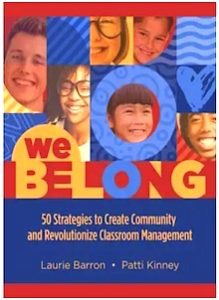Classroom Management Anchored in Community
We Belong: 50 Strategies to Create Community and Revolutionize Classroom Management
By Dr. Laurie Barron and Patti Kinney
(ASCD, 2021 – Learn more)
Reviewed by Michael McLaughlin

Throughout the pandemic, we were reminded that community doesn’t just happen. Rather, building community is hard, intentional, and unceasing work that is also an inspiring and important element of the learning process.
As Head of Middle School at Austin Prep in Reading, Massachusetts, I came to truly appreciate that our school is not just a campus; it is instead a lived opportunity in which students, teachers, administrators, and families share their experiences, ideas, and energy towards the common purpose of forming the hearts and minds of young people.

The community that teachers and students build together in classrooms is critical to students’ well-being, engagement with learning, and future growth. Indeed, Maslow’s Hierarchy of Needs places community as a foundational, essential need that must be met before authentic and deep learning can take place.
We Belong: 50 Strategies to Create Community and Revolutionize Classroom Management by Laurie Barron and Patti Kinney is a superb resource for educators and administrators across K-12. A practical guide rooted in research and lived experience, We Belong offers strategies teachers can implement to optimize opportunities for students’ learning success by addressing belonging through classroom management.
What is Belonging?
The authors define belonging, an essential attribute of community, as “the perception one has of being accepted, valued, and included in a particular group or setting.” That feeling of belonging has many pro-social benefits for students: attendance, self-confidence, engagement, achievement, and resiliency to name a few.
Not feeling that sense of belonging can lead to feelings of anxiety, anger, the erosion of self-worth, and a propensity towards increasingly risky or disruptive behaviors.
Barron and Kinney make a compelling case for a community-focused approach to classroom management. Classroom management sets the context and climate for belonging. Policies and procedures are not just rules; they are the norms of the group and contribute towards cultivating a safe environment for community to take root and grow.
Students – the community in the classroom – must understand these norms, embrace them, and be able to execute them, and there is an expectation that they are explicitly taught, consistently practiced, and constantly refined. As educators, we have the responsibility and capacity to maximize a student’s sense of belonging. Barron and Kinney provide a pathway for doing so.
Tools of the Trade
Barron and Kinney offer 50 strategies for educators to incorporate into their practice. Though it is helpful to set expectations for the classroom at the start of term, the book presents a series of strategies for group work, class discussions, and student self-reflection that can be implemented at any time of the year.
The authors note ways to adapt the strategies to different grade levels, subjects, and circumstances. Research, practical advice, checklists, PDF resources like templates and surveys, and even troubleshooting guides are included to empower teachers to implement these strategies throughout the school year.
Each chapter focuses on a fundamental aspect of classroom culture and learning: safe, enriching and consistent environments; fostering crucial social and emotional skills; academic experiences that promote mastery and competence; and helping students work, grow, and learn more successfully in groups.
A Resource for the School Year
As the son of two educators and a brother to two more, I know that the work of a teacher is never done. The summer months are as much about rejuvenation as they are about planning ahead for students in September. We Belong acknowledges this prep work by grouping several start-of-school strategies together. These strategies will help educators begin the new academic year with a mindset of belonging.
Chapter One includes several self-reflection prompts and active reading tasks that promote an understanding of community and offers a series of tips to design a first day and first week plan to kick off those belonging practices in the right way.
One piece of advice that the authors share is a critical and one all teachers of all grades and disciplines should consider: the goal for the first day is not to communicate content. The goal is to convey culture; to communicate that this classroom is a safe place where students and teachers are serious about learning and success, and that this is a place where students want to return.
Subsequent chapters walk teachers from bell to bell, embedding a belonging mindset and intentionality about community into a variety of classroom practices and instructional strategies.
For example, Chapter 6 includes several whole-class instructional techniques while Chapter 7 takes a deep dive into group work and has tips and tricks that I plan to implement in my pedagogy as I look ahead to collaborative projects in class in the year ahead. Students identify how the group will work, what success will look like, and how they contributed to making that happen.
A Resource to Revisit
One point that Barron and Kinney make clear is that community is not a checklist item that can be crossed off; community is something that must be worked on every day. Each strategy presented in this book must be carefully thought, creativity taught, and constantly refined. The structure of the book helps educators adopt a mindset of thinking of community not in a linear way but rather as a loop: the work is never done.
In We Belong, Barron and Kinney’s community-forward approach to classroom management promotes a culture in which schools can strive to be more than places where students learn skills, facts, and figures, but also “places where they can discover who they are and who they want to become.”
Discover more ideas from Barron and Kinney
in their MiddleWeb article:
Kids Need Us to Keep These 25 Promises.
Michael McLaughlin is the Head of Middle School at Austin Preparatory School in Reading, Massachusetts. The 2019 recipient of the A+ Administrator Award from the New England League of Middle Schools (NELMS), McLaughlin also facilitates workshops for the PD Collab and has appeared on “The Teacher As” podcast. McLaughlin is on the NELMS Board of Directors and on the advisory board of Buckingham Education in the United Kingdom.






























